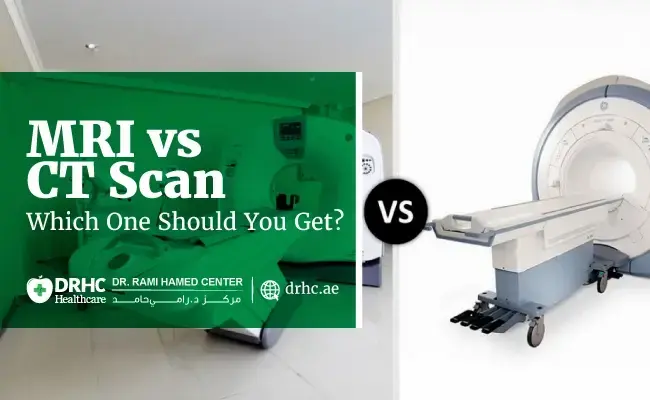
Whether you’re a professional athlete, a weekend runner, or simply enjoy staying active, sports injuries can happen to anyone. A sprained ankle during football, a sore shoulder after tennis, or knee pain after a hike can quickly impact your mobility and quality of life. In many cases, an X-ray is the first imaging test performed. But what if the pain persists, and the X-ray comes back normal?
At the Dr. Rami Hamed Center (DRHC) in Dubai, we often see patients who are frustrated because they still don’t have answers after an initial evaluation. This is where MRI (Magnetic Resonance Imaging) becomes a powerful tool. When X-rays aren’t enough to reveal the problem, an MRI can provide a much clearer view of what’s happening inside your body, especially in the soft tissues that are most commonly affected by sports injuries.
Why X-rays Sometimes Fall Short
X-rays are excellent at showing bones and fractures. But they can’t detect many of the soft tissue injuries that occur during sports or physical activity, such as:
- Torn ligaments (e.g., ACL injuries)
- Meniscus tears in the knee
- Muscle strains or partial tears
- Tendon injuries (like Achilles tendonitis)
- Cartilage damage
- Stress fractures, which may not appear on early X-rays
So if you’re still in pain after rest and initial treatment—and your X-ray results are normal—an MRI scan may be necessary to uncover the true source of the problem.
What Is an MRI and How Does It Help?
MRI uses powerful magnets and radio waves to create detailed images of soft tissues, bones, and joints. Unlike X-rays, MRIs show muscles, ligaments, tendons, cartilage, and even subtle inflammation or swelling inside a joint.
At DRHC Dubai, we use advanced MRI technology to:
- Detect hidden injuries
- Confirm a clinical diagnosis
- Plan appropriate treatment (conservative or surgical)
- Monitor recovery progress
An accurate diagnosis means fewer delays, fewer complications, and a better chance of returning to your normal activities sooner.
When Should You Consider an MRI for a Sports Injury?
You may benefit from an MRI scan if:
- Pain continues for more than 2–3 weeks despite rest
- Swelling or bruising is not improving
- The joint feels unstable or “gives out.”
- You experience locking, catching, or limited movement
- There is suspicion of a ligament, tendon, or cartilage injury
- Your initial X-ray was normal, but symptoms persist
Even if your injury doesn’t seem serious, ignoring the signs could result in chronic pain, long-term joint damage, or delayed healing. An early MRI can help avoid unnecessary risks.
What to Expect During an MRI Scan at DRHC Dubai
We understand that medical procedures can feel stressful. Our goal is to make the experience as smooth and comfortable as possible.
Before the Scan
- No special preparation is usually required
- Inform our team if you have any metal implants or medical devices
- Inform our team if you have any metal implants or medical devices
- Wear loose, comfortable clothing (or a gown will be provided)
During the Scan
- You’ll lie still on a padded table that slides into the MRI machine
- The scan is painless, but you’ll hear a series of loud tapping or humming sounds
- You’ll be provided with earplugs or headphones for comfort
- The scan typically takes 20–45 minutes, depending on the area being examined
After the Scan
- You can go home immediately and resume most activities
- A radiologist will analyze the images and share the findings with your treating physician
- A tailored treatment plan will be discussed based on the results
Explore Our Related Blogs
- How Spine Surgery Has Changed in the Last 10 Years
- Understanding Endoscopic Spinal Decompression: Who It Helps
- What to Expect During Recovery from Endoscopic Spine Surgery
- Lower Back Pain That Won’t Go Away? You Might Need a Spine MRI
- MRI for Knee Pain – When It’s Time to Get Scanned
- Shoulder Pain That Won’t Go Away? You May Need an MRI
- MRI for Spinal Pain in Dubai – Lumbar vs Cervical
- Diagnosing a Meniscus Tear with MRI: What to Expect
Frequently Asked Questions
Is MRI safe?
Yes. MRI does not use radiation and is generally safe for most patients. If you have a pacemaker or metal implants, let your doctor know in advance.
Will I feel pain during the scan?
No. The MRI is a non-invasive and pain-free procedure. You may feel some pressure from staying still, but there is no discomfort caused by the machine itself.
What happens if the MRI shows a serious injury?
Don’t worry—finding the problem is the first step to healing. Based on the MRI, your care team will discuss all treatment options, including physiotherapy, injections, or minimally invasive surgery, if needed.
Is MRI covered by insurance in Dubai?
Many insurance plans cover MRI when medically necessary. Our DRHC team will assist with insurance approvals and explain the process clearly.
Expert Sports Injury Care at DRHC Dubai
At the Dr. Rami Hamed Center, we specialize in diagnosing and treating sports injuries with a multidisciplinary approach. Whether you’re recovering from a torn ligament, a stress fracture, or unexplained joint pain, our orthopedic, sports medicine, and radiology teams work closely to ensure you receive accurate, timely, and compassionate care.
Conclusion: Don’t Let an Injury Slow You Down
Sports and physical activity are essential for a healthy lifestyle—but injuries can happen. If your pain isn’t improving or you feel unsure about the next step, MRI imaging can provide the answers you need. It’s a safe, reliable, and non-invasive way to uncover hidden damage and guide you toward the right treatment.
Consultations and imaging services are available at DRHC Dubai, where your recovery is our priority.
📞 +971 4 279 8800
🌐 www.drhc.ae
📍 Dubai Healthcare City, Building 52
Topic: Radiology orthopedic MRI









Leave a comment